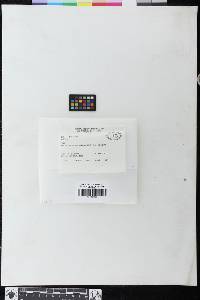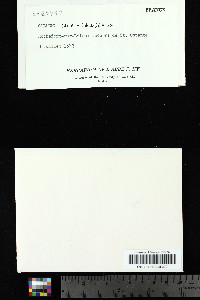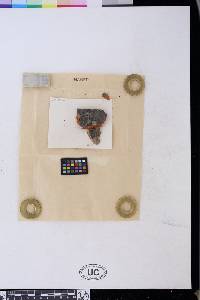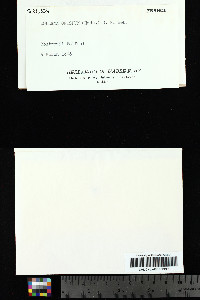
Consortium of Lichen Herbaria
- building a Global Consortium of Bryophytes and Lichens as keystones of cryptobiotic communities -
- Home
- Search
- Images
- Species Checklists
- US States: O-Z >
- US National Parks
- Central America
- South America
- US National Parks
- Southern Subpolar Region
|
|
|
|
Family: Collemataceae
[Collema crispum (Hudson) Weber ex F.H. Wigg., moreCollema crispum f. crispum (L.) Weber ex F.H. Wigg., Collema crispum f. graniforme Harm., Collema crispum f. nudum Schaer., Collema crispum subsp. crispum (L.) Weber ex F.H. Wigg., Collema crispum var. crispum (Huds.) Weber ex F.H. Wigg., Collema crispum var. graniforme (Hoffm.) Ozenda & Clauzade] |
Nash, T.H., Ryan, B.D., Gries, C., Bungartz, F., (eds.) 2004. Lichen Flora of the Greater Sonoran Desert Region. Vol 2. Thallus: foliose, often forming rosettes, small to medium sized, 2-3(-5) cm wide, deeply and broadly lobate lobes: often crowded and imbricate, 0.5-1(-5) mm wide, thin (70-200 µm), rounded, flat or concave, often ascending and somewhat ear-shaped; margins: thin, entire or crenate upper surface: smooth, dark green, olive or black, bright green in shaded habitats, occasionally pruinose isidia: at first globose but soon scale-like, c. 0.15-0.3 mm wide, sometimes obscuring the thallus lower surface: concolorous or paler, with white rhizines, sometimes forming ±scattered hapters Apothecia: absent or common, appressed to sessile with slightly constricted base, 1-2(-2.5) mm broad disc: plane, light to dark red-brown, smooth, epruinose or rarely pruinose thalline margin: thin, granulose to lobulate, with primitive pseudocortex true exciple: thin, subparaplectenchymatous to nearly euthyplectenchymatous hymenium: hyaline, 130-170 µm tall asci: narrowly clavate, 8-spored ascospores: hyaline, ovoid to subellipsoid, with rounded ends, 4-celled or sometimes submuriform, (17-)26-34 x (8.5-)13-15(-18) µm Pycnidia: marginal or laminal, ±immersed, pale conidia: bacilliform, usually slightly swollen at the ends, 4.5-6 x 1.5-1.8 µm Spot tests: all negative Secondary metabolites: nonse detected. Substrate and ecology: often on calciferous soil, also World distribution: North America, Iceland, Europe, northern Africa, Near and Middle East, India, and New Zealand Sonoran distribution: quite common in Arizona, also southern California, Baja California, Baja California Sur, and Sonora. Notes: Collema crispum is distinguished by its numerous scale-like isidia resembling small lobules and its often ear-shaped, overlapping, flat to concave lobes. Rarely, the lobes and/or apothecial discs are pruinose. |
Powered by Symbiota





































































































